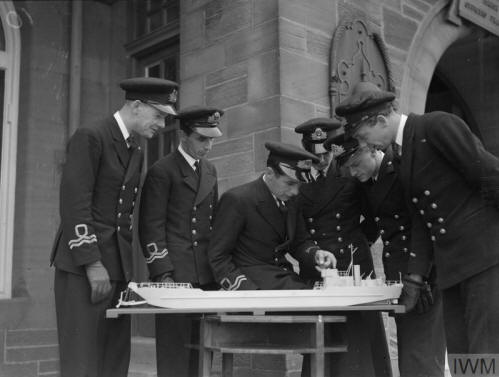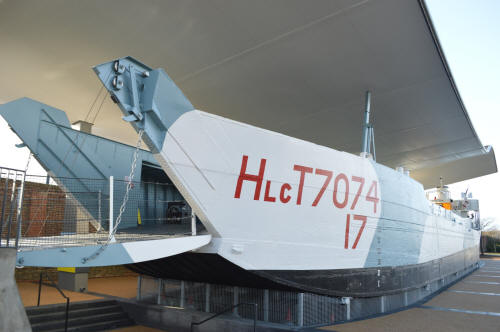|
The Restoration of Landing Craft Tank (LCT)
7074.
UK Landing Craft survivor of WW2 - an enduring focus for
remembrance and education.

Background
This website has recorded the personal
recollections of landing craft crews for 21 years, including
40 D Day stories and many other major landings in North Africa, Sicily, Italy, Southern France and
Holland.
[Photo. LCT 7074 before restoration started.
© IWM].
The crews have seldom received the public
recognition they deserve in delivering the Allied Armies, their transport, equipment,
munitions and supplies to the landing
beaches often under heavy enemy fire, explosive beach obstacles and the
vagaries of weather and tide.
 The National Museum of
the Royal Navy has helped provide an enduring focus of remembrance for these brave
young men, and their incredible achievements, through the restoration of Landing Craft Tank 7074 - the
only 2nd World War LCT survivor in the UK.
She now stands
alongside the
D
Day Story on the seafront at Southsea. It is a jaw dropping and
humbling experience to learn about its young crew
and the vital, hazardous work they undertook. The National Museum of
the Royal Navy has helped provide an enduring focus of remembrance for these brave
young men, and their incredible achievements, through the restoration of Landing Craft Tank 7074 - the
only 2nd World War LCT survivor in the UK.
She now stands
alongside the
D
Day Story on the seafront at Southsea. It is a jaw dropping and
humbling experience to learn about its young crew
and the vital, hazardous work they undertook.
[Image. Extract from the Admiralty's "Green
List" showing the disposition of 7074 just prior to D Day].
 On the 7th June 1944,
as 20
year old Sub Lieutenant John Baggott, a trainee solicitor from Swindon,
steered his craft towards the Normandy beaches, he unwittingly secured his
place in the history of the largest amphibious invasion force ever mounted. It was his great distinction to command LCT 7074, one of 850 such
landing craft deployed during Operation Neptune, the amphibious phase
of Operation Overlord. 7074 is destined to
become a national icon for all WW2 landing craft deployed before, during
and after D Day with its inclusion in the register of the
National Historic Fleet under certificate number 713. On the 7th June 1944,
as 20
year old Sub Lieutenant John Baggott, a trainee solicitor from Swindon,
steered his craft towards the Normandy beaches, he unwittingly secured his
place in the history of the largest amphibious invasion force ever mounted. It was his great distinction to command LCT 7074, one of 850 such
landing craft deployed during Operation Neptune, the amphibious phase
of Operation Overlord. 7074 is destined to
become a national icon for all WW2 landing craft deployed before, during
and after D Day with its inclusion in the register of the
National Historic Fleet under certificate number 713.
The
Crew
Sub Lt Baggot and his
equally youthful 2nd in command, Sub Lt Philip Stephens, in common with
the vast majority of officers who commanded the 4,000 landing craft of
many types on D Day, were relatively inexperienced officers recruited from the Royal
Naval Volunteer Reserve (RNVR). Many were weekend sailors with limited seafaring
experience who lacked the knowledge, skills and experience of their full
time Royal
Navy counterparts. They, however, were simply not available in the numbers required
to take command of these craft. These were
extraordinary times requiring extraordinary solutions, which placed a heavy
burden of responsibility on the young shoulders of the RNVR recruits._small.jpg)
[Photo montage taken inside LCT 7074 in Oct
2019 by San Ward. Note the fragility of the structure in some places].
For the purposes of
training and offensive amphibious operations against the enemy, all RNVR landing craft officers and
RN ratings and their Royal Navy landing craft, were attached to
the Combined Operations Command, itself staffed by Royal Navy, Army and
Royal Air Force personnel under the command of naval men Keyes and
Mountbatten from July 1940 to October 1943 and Major General Laycock until
1947. Under their stewardship and
close liaison with the Joint Chiefs of Staff, they provided extensive
training in the use of landing craft through dozens of
Training Establishments,
mainly in central Scotland and the south of England. Visit our
Home Page to see how this
extraordinary situation arose.

This was, arguably,
the largest training exercise in history involving many hundreds of
thousands from the three services over a four year period from late 1940
to the end of the war. Around 250,000 mainly RNVR, RN and Army personnel,
attended the
No 1 Combined Training Centre
at Inveraray (Scotland) alone, of which HMS Quebec was the Naval
component.
[Photo. Invasion craft officers, 16th
May 1944 at the Combined Training Centre 'HMS Dinosaur' where
officers and ratings underwent basic training in the use of large landing
craft. This photo shows officers studying a model of an LCT.
© IWM (A 23630)].
The task of 7074's
twelve man crew was to deliver their precious cargo of 10 tanks and their
crews to Gold Beach, Normandy – and then, for as long as necessary, to
provide a cross channel ferry service carrying more tanks, lorries,
equipment and supplies from the UK to Normandy to ensure the advancing
Allied Armies had the means to continue their progress towards Berlin. Any
loss of momentum would allow the enemy to regroup and counter attack, with
potentially disastrous consequences.
 The 235 Mark 3 LCTs
were 59
metres long with a beam of 9.1m. They displaced 300 tons and were powered by 2 x 460 hp
(343Kw) Paxman diesel
or Sterling petrol engines delivering 9 knots (17 kph/10 mph) through two shafts. In design,
their
blunt bow, flat bottom and chronic lack of power defied
conventions in ship design built up over generations. The unsurprising
consequences were
vessels whose dismal sailing characteristics were a challenge for their
crews in maintaining a planned course and speed, particularly in strong
winds or tidal currents. Of course, their shallow draft and forward
loading/unloading ramp for landings onto unimproved beaches, determined its
unconventional design. They carried either 2 single 20mm Oerlikon guns or 2 single 40mm Bofors. The 235 Mark 3 LCTs
were 59
metres long with a beam of 9.1m. They displaced 300 tons and were powered by 2 x 460 hp
(343Kw) Paxman diesel
or Sterling petrol engines delivering 9 knots (17 kph/10 mph) through two shafts. In design,
their
blunt bow, flat bottom and chronic lack of power defied
conventions in ship design built up over generations. The unsurprising
consequences were
vessels whose dismal sailing characteristics were a challenge for their
crews in maintaining a planned course and speed, particularly in strong
winds or tidal currents. Of course, their shallow draft and forward
loading/unloading ramp for landings onto unimproved beaches, determined its
unconventional design. They carried either 2 single 20mm Oerlikon guns or 2 single 40mm Bofors.
[Photo left. 7074 7th June 1944 on
Gold Beach with enemy prisoners for return to the UK.
© IWM].
The
Restoration Mission
LCT 7074 is the
only vessel on public display from the D Day campaign other than HMS
Belfast, moored in the Thames. As a 10,000 tonne cruiser providing gunfire
support from miles offshore, she commemorates only half of the story of
naval participation in the operation - the other half being the landing
craft that faced the enemy's wrath during the initial landings.
The heavy bombarding
ships of the Allied navies provided vital cover for the invading fleet and
shelled known enemy targets such as heavy gun emplacements on and around
the landing beaches and inland as Forward Observation Officers (FOOs)
identified new targets.
 The task of the many types of Landing Craft was
very different in delivering "boots on beaches" and all the tanks,
transport, artillery and provisions the invading force needed to initiate and sustain
the invasion. It was all the more remarkable an achievement since landing
craft design, development and manufacture had little history
prior to WW2. The task of the many types of Landing Craft was
very different in delivering "boots on beaches" and all the tanks,
transport, artillery and provisions the invading force needed to initiate and sustain
the invasion. It was all the more remarkable an achievement since landing
craft design, development and manufacture had little history
prior to WW2.
[LST 7074 under its canopy at the
D-Day Story
on Clarence Esplanade, Southsea, Hampshire].
You tube video of
7074's recovery from a Liverpool dock.
Visit LST 7074
To plan your visit, please click on the D Day Story website at the link
below. Use postcode PO5 3NT for sat
nav.
https://theddaystory.com/plan-your-visit/what-to-see-at-the-d-day-story/d-day-landing-craft-tank-lct-7074/
|



_small.jpg)




